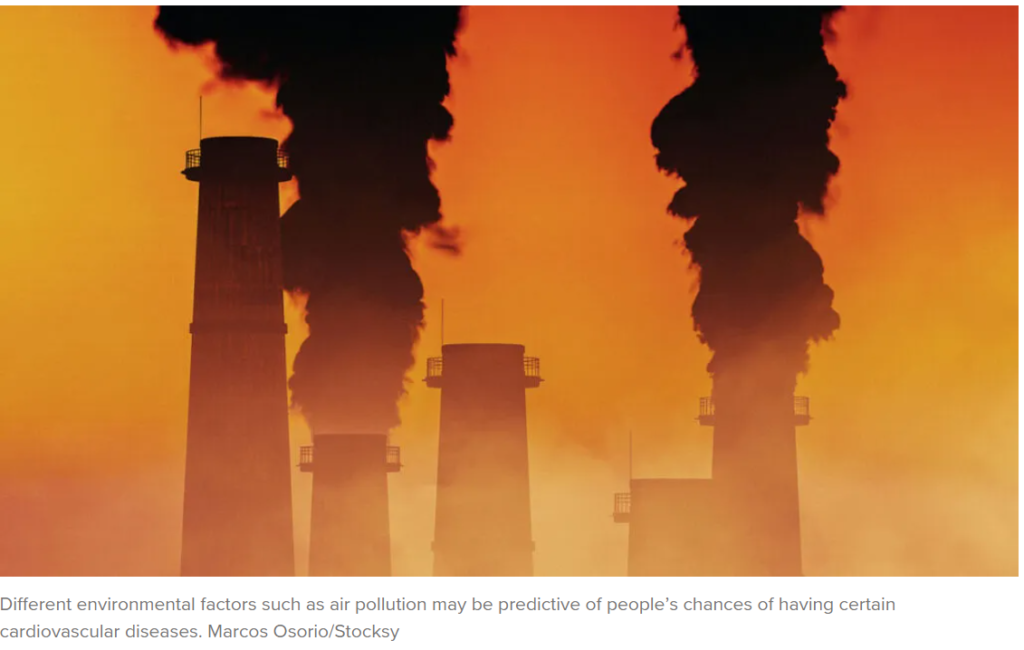- Environmental factors play a role in health, with research finding that people living in certain areas have a higher risk for health problems and mortality.
- Multiple factors such as air pollution and fuel-burning methods can impact cardiovascular and all-cause mortality risk at varying degrees, according to a new study.
- The authors argue that to improve our environments and decrease the health risks associated with it, we need to take multiple approaches.
Scientists in many areas of study seek to understand what increases people’s risk for death. One area of particular interest is environmental factors that contribute to cardiovascular-related mortality.
A recent studyTrusted Source published in PLoS ONETrusted Sourceexamined the associated risk between certain environmental exposures and mortality, including cardiovascular mortality.
Researchers found that the risk for cardiovascular-related death is linked to many factors, including ambient air and household air pollution.
The environment’s impact on health
Several factors can impact health. For example, genetics play a role in people’s tendencies to develop certain disorders or diseases. However, people’s environment can also play into health risks.
According to the World Health OrganizationTrusted Source, “as much as 24% of all deaths worldwide were attributable to the environment.” The WHO notes that several environmental factors can contribute to these deaths, including the following:
- air pollution
- water and sanitation
- exposure to harmful chemicals
- severe weather events, including increasing heat waves
Of the top ten causes of environmental death, ischemic heart disease ranks number one. Researchers are still working to discover what environmental factors pose the most risk to heart health and how people can reduce their risk.
Assessing mortality
This study involved a multiethnic cohort of 50,045 participants in Iran.
The researchers looked at the risk association between specific environmental exposures and mortality. Specifically, they looked at both all-cause mortality and cardiovascular mortality.
Their research examined the following environmental factors:
- ambient fine particulate matter air pollution
- household fuel use and ventilation (which can impact household air pollution)
- proximity to traffic
- distance to percutaneous coronary intervention (PCI) (How far would they need to travel if they had heart problems?)
- socioeconomic environment
- population density
- local land use and nighttime light exposure
The researchers accounted for individual risk factors and adjusted for these in the analysis. The major findings that stood out were:
- Those in areas of high air pollution were 17% more likely to experience cardiovascular mortality and 20% more likely to experience all-cause mortality.
- Those who used biomass fuels such as wood or dung without a chimney were 36% more likely to experience a cardiovascular-related death and 23% more likely to experience all-cause mortality.
- Those who used kerosene fuel without a chimney were 19% more likely to experience cardiovascular mortality and 9% more likely to experience all-cause mortality.
The distance to help with cardiovascular problems was also significant. As the length from a PCI increased, so did the risk for all-cause and cardiovascular mortality.
“Air pollution exposures contributed a significant burden of cardiovascular disease, similar to tobacco smoke…The study demonstrates that environmental risk factors are present and evaluable in rural, low-resource settings.”
— Dr. Hadley Michael, study author
Study limitations
The study provided extensive data due to the number of participants included and the number of risk factors researchers examined.
However, it did have some limitations. First, researchers only noted the village or neighborhood for each participant rather than individual addresses for privacy reasons, which could have impacted data collection for certain factors.
They also collected the data on the year participants enrolled in the study. Because of this collection method, researchers could not account for previous exposures, changes over time, or acute exposures.
Inaccuracies in data collection regarding socioeconomic status, as well as using participants’ fuel use and ventilation levels to examine air pollution exposure indirectly may have affected the results.
How to reduce risk
The study notes the importance of looking at and addressing environmental risk factors related to cardiovascular health. It is likely that reducing risk and improving these environmental factors will involve the work of multiple people and groups.
Dr. Aaron J. Cohen, consulting principal scientist with the Health Effects Institute, told Medical News Today that continued and expanded monitoring of air pollution was currently the most critical need.
“Further reductions in pollution levels and their associated burden of disease will require a comprehensive and coordinated air quality management approach that involves multiple actors in government, including agencies of health, energy, and environment, as well as civil society, including environmental and public health NGOs [non-governmental organizations] and the press.”
— Dr. Aaron J. Cohen
Cohen is currently involved in collaborations with scientists at Tehran University Medical School, one of the institutions involved in this paper.
Dr. Hadley elaborated to MNT on the future of healthcare in light of these findings.
“Increasingly, physicians will need to answer questions about environmental risk and offer suggestions and interventions to protect their patients. This will require further research to identify the most effective interventions for specific risk factors and patient populations,” he said.
“Trials are needed to test the efficacy of interventions to protect patients from environmental risk factors. For example, air filtration or facemasks to reduce the risk of air pollution exposures,” he added.
Article Credits: Medical News Today

Pingback: Curbing air pollution is among top 10 priorities of Delhi government: Environment Minister Gopal Rai - SLSV - A global media & CSR consultancy network
Pingback: Industrialists to get training to cut ammonia in Yamuna - SLSV - A global media & CSR consultancy network